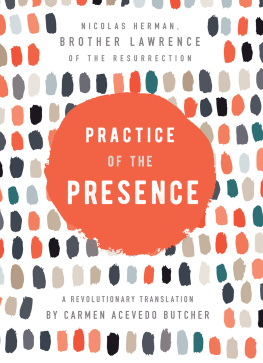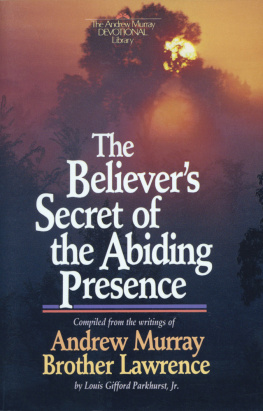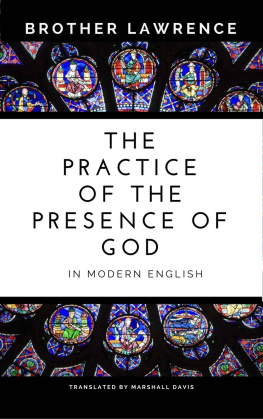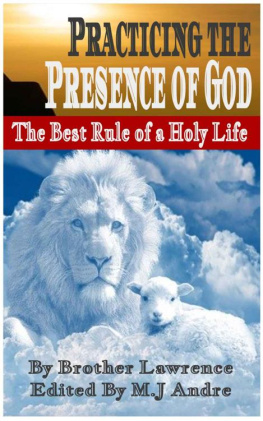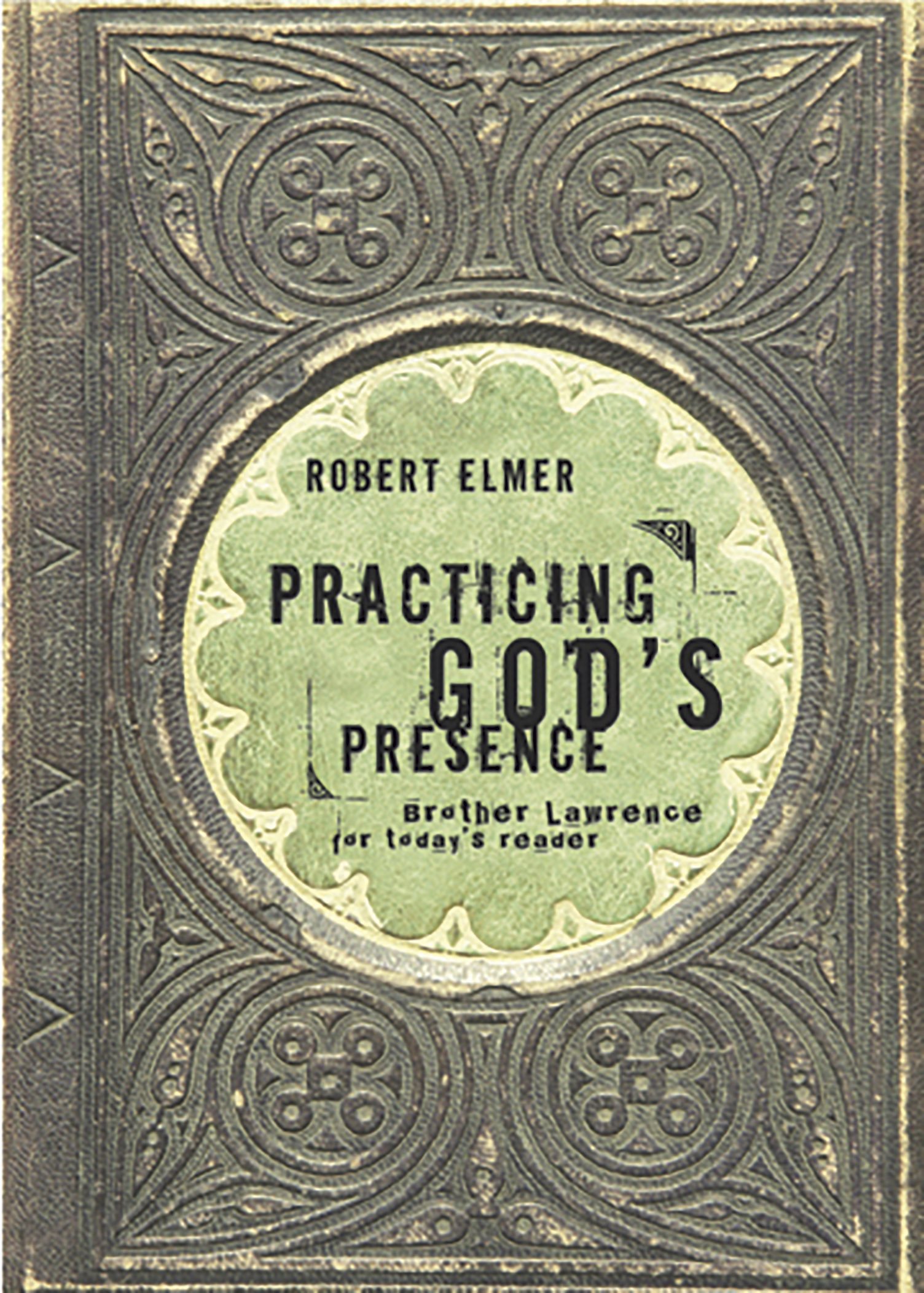Brother Lawrences simple but profound messages are vital ones for modern-day America. This book will pierce the superficiality of twenty-first-century Christianity.
G EORGE G ALLUP J R. , The George H. Gallup International Institute
This spiritual classic, in modern rendering, will continue to open our eyes wide to the overwhelming and benevolent presence of God.
M EL L AWRENZ , P H. D., senior pastor, Elmbrook Church; author of Putting the Pieces Back Together
Robert Elmer has crafted a wonderful gift by offering a new, refreshing look at The Practice of the Presence of God. May new people be surprised and blessed by this new work of an old friend.
C HARLES M ORRIS , president and speaker, Haven Ministries
NavPress is the publishing ministry of The Navigators, an international Christian organization and leader in personal spiritual development. NavPress is committed to helping people grow spiritually and enjoy lives of meaning and hope through personal and group resources that are biblically rooted, culturally relevant, and highly practical.
For more information, visit NavPress.com.
Practicing Gods Presence: Brother Lawrence for Todays Reader
Copyright 2005 by Robert Elmer. All rights reserved.
A NavPress resource published in alliance with Tyndale House Publishers, Inc.
NAVPRESS and the NAVPRESS logo are registered trademarks of NavPress, The Navigators, Colorado Springs, CO. TYNDALE is a registered trademark of Tyndale House Publishers, Inc. Absence of in connection with marks of NavPress or other parties does not indicate an absence of registration of those marks.
Cover design by studiogearbox.com
Cover image by Steve Gardner/Pixelworks
Creative Team: Terry Behimer, Liz Heaney, Arvid Wallen, Kathy Mosier, Pat Reinheimer
Unless otherwise indicated, all Scripture quotations are taken from THE MESSAGE, copyright 1993, 1994, 1995, 1996, 2000, 2001, 2002 by Eugene H. Peterson. Used by permission of NavPress. All rights reserved. Represented by Tyndale House Publishers, Inc. Scripture quotations marked NIV are taken from the Holy Bible, New International Version, NIV. Copyright 1973, 1978, 1984 by Biblica, Inc. Used by permission. All rights reserved worldwide.
Some of the anecdotal illustrations in this book are true to life and are included with the permission of the persons involved. All other illustrations are composites of real situations, and any resemblance to people living or dead is coincidental.
For information about special discounts for bulk purchases, please contact Tyndale House Publishers at , or call 1-800-323-9400.
Lawrence, of the Resurrection, Brother, 1611-1691.
[Pratique de la prsence de Dieu. English. Selections.]
Practicing Gods presence : Brother Lawrence for todays reader / updated and revised by Robert Elmer.
p. cm.
Includes bibliographical references.
ISBN 1-57683-655-X
1. Christian lifeCatholic authors. I. Elmer, Robert. II. Title.
BX2350.3.L3813 2005
248.482dc22
2004019468
Build: 2021-04-21 22:34:05 EPUB 3.0
A BOUT T HIS U PDATED V ERSION
The Practice of the Presence of God has been passed down for well over three hundred years in many editions and languages. A favorite of evangelical Protestants as well as Catholics, it has been required reading at many colleges and loved as a personal devotional. As our language changes, we need to reflect once more on what this simple, uneducated monk thought about in the back room of a monastery kitchen or behind a stack of broken sandals. We know from several accounts that although Brother Lawrence had only a grade-school education, he spoke with a genuine common sense that people admired. He was also known for his simple approach to the spiritual life; his honesty, warmth, and humor; and his uncluttered approach to relationships and to faith itself.
But what did he really say, and how did he say it?
In this updated edition Ive sought to answer these questions by taking the more dated language of earlier editions and redressing it in the English we speak today, all the while remaining faithful to the original intent. Keep in mind that Brother Lawrence spoke French.
Along the way Ive had the privilege of reviewing a number of different versions, from the 1895 version published by Fleming Revell to several more recent editions from the 1970s, 80s, and 90s. In cases where editors and translators have disagreed over the meaning of obscure wording, Ive taken all opinions into account as I searched for the four Cs: clarity, consensus, consistency, and context. Any misinterpretations are mine.
Ive also tried to present Brother Lawrences famous letters in chronological order, though not all scholars agree on the order in which they were written.
This is by no means a word-for-word translation. This is a riskier proposition, a thought-for-thought edition. The risk of such an update is that trying to match fresh metaphors to the authors original intent can sometimes be tricky. On the other hand, the payoff is well worth it when we sidestep obsolete language that once kept us in a fog. The light clicks on! Finally the words make sense. My goal is that this edition will have people saying, Oh, so thats what he meant! And then, as Hannah Whitall Smith noted in her introduction to the 1895 edition, What Brother Lawrence did all can do. Can we? The first step is understanding what he really was saying. My prayer is that God will reach a new generation with this message of simple devotion to Jesus Christa message clear and uncluttered, like the life of service and love Brother Lawrence modeled.
Robert Elmer
Hannah Whitall Smith, introduction to Brother Lawrence, The Practice of the Presence of God the Best Rule of a Holy Life: Being Conversations and Letters of Nicholas Herman of Lorraine (Brother Lawrence), trans. (New York: Revell, 1895), p. iii.
Brother Lawrence: A S HORT B ACKGROUND
Its interesting how the writings and sayings of an obscure French monk from the 1600s can have such a profound influence on the lives of people today through the pages of a book he never intended to write. Although Brother Lawrence has been called a mystic, an uneducated philosopher, a spiritual innovator, and a saint, he really was none of the above.
He was born Nicholas Herman in 1614 in Hrimnal, part of the Lorraine district of France, and we know little of his childhood (not surprising, considering who he was and how long ago he lived). His devout parents could afford to send him to elementary school only, and as a young man he enrolled in the army of Lorraine to fight in the Thirty Years War.
Theres little doubt Nicholas witnessed the worst of war, considering that the Thirty Years War was a brutal conflict. He was even captured as a spy and nearly executed until he talked his way out of danger and returned to his company. He eventually was sent home after receiving a serious leg injury at the Battle of Rambervillers in 1635. He never fully recovered.
Back home, he served for a short time as a valet to a well-known banker, William de Fieubet, who was treasurer to the French king. The job didnt last long; Nicholas thought himself clumsy and later said he broke everything. During these years its likely he sought advice from his uncle, a Carmelite monk, because in 1640, at age twenty-six, Nicholas left home and entered the Carmelite monastery on the Rue Vaugirard in Paris. Without the education (particularly in Latin) to qualify for the higher clerical orders, he entered as a lay brother and was initially assigned to work in the kitchen. He either chose or was given the name Brother Lawrence of the Resurrection.



